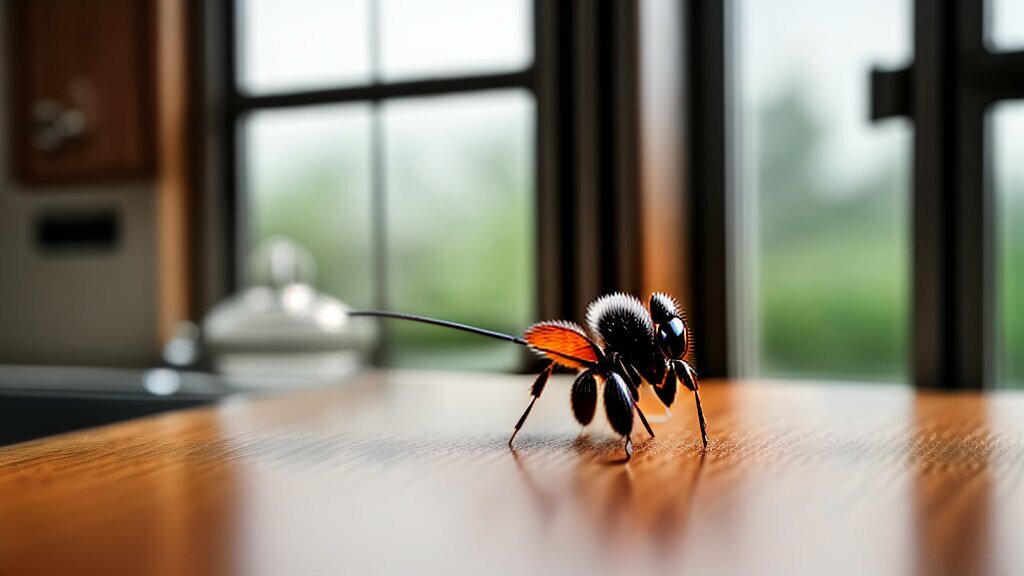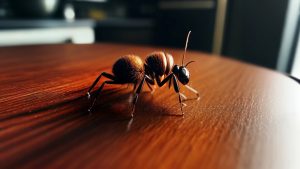Welcome to our comprehensive guide on sugar ant control in the kitchen. If you’ve ever encountered a sugar ant infestation, you’re familiar with the frustration of safeguarding your food and kitchen surfaces from these persistent pests. Luckily, you can take several easy solutions and preventative measures to ensure an ant-free environment in your kitchen. In this article, we’ll provide the following:
- Valuable tips on identifying sugar ants.
- You are preventing them from entering your kitchen.
- I am eliminating any existing infestations.
Let’s get started!
Key Takeaways:
- Sugar ants can be effectively controlled with the proper techniques and prevention measures.
- A clean and dry kitchen is crucial for sugar ant control and prevention
- Natural remedies, ant baits, and pest control services can help manage sugar ant infestations
- Maintaining a consistent and proactive approach to sugar ant prevention is critical in keeping your kitchen ant-free

Identifying Sugar Ants in Your Kitchen
Before we dive into solutions, it’s crucial to identify if you’re dealing with sugar ants in your kitchen. These ants are tiny, usually up to 3mm long, and are light brown. They have distinctive characteristics like narrow waists and curved antennas, which can help distinguish them from other types of ants.
If you’re not sure if you have sugar ants, look for the following signs:
- Small clusters of ants near sources of sweet food, like sugar or honey
- A trail of ants leading from a source of food to their nest
- Tiny holes or cracks along your walls or floors where ants may be entering your home
- The presence of small white eggs or black specks (and feces) near infested areas
If you’ve identified these signs in your kitchen, there’s a good chance you have a sugar ant infestation on your hands.
What to do if you have a sugar ant infestation
If you suspect you have a sugar ant infestation, it’s advisable to take swift action to avoid its escalation and the potential for a more significant issue. Keep your kitchen clean and dry, try natural remedies, and use ant baits or traps to eliminate them. If the infestation persists, it’s time to call pest control professionals for treatment.
Now that we know how to identify sugar ants let’s move on to preventing them from infesting your kitchen.
Prevention Tips for Sugar Ants in Your Kitchen
Prevention is the key to controlling sugar ants in your kitchen. By taking steps to prevent an infestation, you can avoid the need for extensive treatments and keep your kitchen free of pests. Here are some practical tips to help you prevent sugar ants from infesting your kitchen:
- Store food properly: Store food in airproof containers or refrigerators to prevent ants from accessing it.
- Clean regularly: Wipe down counters and surfaces daily to remove spills that attract ants.
- Take out the trash: Ensure that your trash cans are sealed and taken out regularly.
- Make sure to leave dishes out: Wash them promptly, and don’t leave them sitting in the sink for extended periods.
- Trim back foliage: If you have trees or bushes near your kitchen, trim them so ants can’t use them to access your home.
- Monitor pet food: Ants are attracted to pet food, so make sure that pet food dishes are cleaned after each use and that food is not left out.
These simple prevention tips can significantly reduce the risk of a sugar ant infestation in your kitchen. However, if you are dealing with these pests, don’t worry! There are still plenty of practical solutions available to you.
Keep Your Kitchen Clean and Dry
One of the best ways to control sugar ants in your kitchen is to keep it clean and dry. Sugar ants are attracted to food scraps and spills, so removing these food sources can significantly reduce ant activity in your kitchen.
Start by regularly wiping your countertops and floors with soap and water to eliminate food residue. Pay special attention to areas where spills or crumbs are likely to accumulate, such as around the stove or sink.
It’s also essential to keep your kitchen dry, as sugar ants are attracted to moisture. Fix any leaky faucets or pipes and wipe up any standing water promptly. Ensure your kitchen is well-ventilated, as this can help prevent moisture buildup.
Finally, don’t leave any dirty dishes in the sink overnight. Wash them promptly or load them into the dishwasher. Sugar ants will quickly find their way to leftover food stuck to words or in the sink drain.
Natural Remedies for Sugar Ants
When dealing with sugar ants in your kitchen, you must employ effective strategies, such as baking soda, to rid your kitchen of these pests and maintain a clean and ant-free environment.We have some effective remedies for you if you prefer using natural solutions. Here are some of the best natural remedies for sugar ants:
Vinegar Solution
Create a mixture by combining equal water and vinegar in a spray bottle. Spray the solution in areas where you see sugar ants, such as countertops, windowsills, and floors. Repeat the process every day until you no longer see any ants. Vinegar is known to disrupt ant pheromone trails, making it harder for them to find their way back to your kitchen.
Essential Oils
Use essential oils like peppermint, cinnamon, or tea tree oil to repel sugar ants. Immerse a cotton ball in your chosen essential oil and position it near ant entry points or areas with ant activity. Alternatively, mix a few drops of essential oil with water and spray the solution in the exact locations. Repeat these steps until the ants are no longer present.
Borax and Sugar
Mix equal amounts of borax and sugar in a bowl. Place the mixture on a small plate or in a jar lid near ant entry points. The sugar will attract the ants, and the borax will work to eliminate them. Take care to keep the mixture out of reach of pets and children.
Lemon Juice
Squeeze fresh lemon juice on areas where you see sugar ants. Repeat this process every day until the ants are gone. Lemon juice contains citric acid, which works as a natural insecticide.
Diatomaceous Earth
Sprinkle food-grade diatomaceous earth near ant entry points or areas where ants have been seen. Diatomaceous earth is a natural powder that can puncture the exoskeleton of insects and cause them to become dehydrated. Wear a mask when handling diatomaceous earth to avoid breathing in the dust.
These natural remedies can potentially effectively repel or eliminate sugar ants from your kitchen. However, it’s important to note that these remedies may not work for severe infestations, in which case professional help may be necessary.
Sealing Entry Points
Once you have identified the entry points where sugar ants are getting into your kitchen, it’s essential to seal them off to prevent further infestations.
Start by cleaning the area around the entry point with soap and water to remove any traces of food or pheromones that may attract sugar ants. Then, apply caulk or sealant to seal up any gaps or cracks present in walls, floors, or windows.
Pay close attention to areas where pipes or wires enter your kitchen, as these are common entry points for sugar ants. Cover gaps around these entry points with a sealant or foam insulation to block off access.
If you have sliding doors or windows, consider installing weather stripping to ensure a tight seal and prevent sugar ants from entering through gaps. Furthermore, screens on windows and doors can effectively keep sugar ants out while maintaining proper ventilation in your home.
By sealing off these entry points, you can significantly reduce the risk of a sugar ant infestation in your kitchen.
Using Ant Baits and Traps
If you’re struggling to control sugar ants in your kitchen, ant baits, and traps can be a helpful addition to your pest management strategy. Ant baits work by luring ants to a food source that contains poison, which they carry back to the colony and share with other ants, eventually leading to colony elimination. Conversely, traps physically capture ants, preventing them from accessing food sources and reproduction.
When using ant baits, placing them strategically in areas where you have noticed ant activity is essential. Avoid placing them directly on ant trails or areas where you have applied other insecticides, as this can repel ants from the bait. Instead, please place them in inconspicuous locations, such as behind appliances or in the corners of cabinets.
| Product | Description | Price |
|---|---|---|
| Terro Liquid Ant Baits | Pre-filled liquid bait stations that kill common household ants | $6.99 for a pack of 6 |
| Raid Ant Baits | Baits that attract and kill ants, including the queen and colony | $9.99 for a group of 4 |
| Combat Max Ant Killing Bait Stations | Ant baits that target and kills the queen and the entire colony | $8.99 for a group of 6 |
Traps are another effective tool for controlling sugar ants. They use a sticky or liquid substance to trap ants, preventing them from accessing food sources and reproducing. Like baits, traps should be placed where you have noticed ant activity, such as along ant trails or near food sources.
| Product | Description | Price |
|---|---|---|
| Terro T300B Liquid Ant Baits | Pre-filled liquid bait stations that kill common household ants | $5.99 for a pack of 6 |
| Combat Max Ant Killing Gel | Gel bait that can be applied to cracks and crevices where ants are entering or traveling | $5.99 for a 27-gram syringe |
| Raid Ant Baits | Lures that attract and kill ants, including the queen and colony | $9.99 for a pack of 4 |
Remember, while ant baits and traps can be practical tools for sugar ant control, they should be used with other preventative measures, such as maintaining a clean and dry kitchen and sealing entry points. Furthermore, cautiously adhering to the instructions and using these products is crucial to ensuring safety for yourself, your family, and your pets.
Calling Pest Control Professionals
When dealing with a persistent sugar ant infestation that doesn’t respond to your control measures, it’s advisable to seek the expertise of pest control professionals. At this point, the population of ants may have grown too large to manage with DIY methods. Pest control professionals possess the expertise and specialized tools to eliminate sugar ants from your kitchen.
When selecting a pest control company, ensure it is licensed and experienced in treating ant infestations. To locate a reputable pest control professional, consider seeking recommendations from acquaintances or family members, and peruse online reviews to confirm that previous clients were content with the services they received. Discuss the cost and treatment plan with the pest control professional beforehand.
During the appointment, the pest control specialist will assess the severity of your sugar ant infestation and recommend the most appropriate treatment plan. This may include using chemical sprays, bait stations, and traps. They may also provide advice on how to prevent future infestations.
Remember that while pest control professionals can effectively eliminate sugar ants from your kitchen, it is essential to maintain a clean and dry kitchen to prevent future infestations.
Maintaining an Ant-Free Kitchen
Congratulations, you have successfully dealt with sugar ants in your kitchen! However, to ensure long-term control, it’s essential to maintain a clean and hygienic environment. Here are some tips to help you keep an ant-free kitchen:
- Clean regularly: Clean countertops and surfaces daily to eliminate crumbs and spills that might entice ants.
- Store food properly: Store it in tightly sealed containers and keep it away from edges and corners where ants can easily access it. This will limit sugar ants’ access to food sources.
- Take out the trash: Dispose of waste regularly and keep garbage cans tightly sealed to eliminate potential food sources for sugar ants.
- Check for leaks: Fix any leaky pipes or faucets to eliminate standing water, which can attract sugar ants.
These easy-to-implement suggestions can keep ants at bay in your kitchen and avoid future infestations. Remember, prevention is critical to effective sugar ant control!
Conclusion
Dealing with sugar ants in your kitchen can be a frustrating and pesky problem, but it’s not impossible to control. Following the tips and techniques in this article, you can effectively eliminate sugar ants and prevent them from infiltrating your kitchen.
Stay Proactive
Remember, prevention is critical in keeping your kitchen free from sugar ants. Keeping your kitchen clean and dry is crucial in deterring these pests from entering your kitchen. Additionally, sealing entry points and strategically placing ant baits and traps can significantly reduce their activity.
Seek Professional Help
If you’ve tried all our recommended solutions and are still dealing with a persistent sugar ant infestation, it may be time to call pest control professionals. Professional pest control services possess the knowledge and tools to eradicate sugar ants from your kitchen efficiently.
Overall, managing sugar ants in your kitchen requires consistent effort and attention. By staying proactive and maintaining a clean and dry kitchen, you can prevent sugar ants from infesting your space and enjoy a pest-free environment.
FAQ
Q: How do I identify sugar ants in my kitchen?
A: Identifying sugar ants is essential before taking any action. Look for tiny, brown ants with a distinct preference for sweet food. They are often found in large numbers near food sources.
Q: What are some prevention tips for sugar ants in my kitchen?
A: To prevent sugar ants, keep your kitchen clean and dry. Taking precautions such as storing food in airtight containers, promptly cleaning up spills, and sealing any potential entry points can help prevent sugar ants from invading your kitchen.
Q: Can I use natural remedies to get rid of sugar ants?
A: Yes, there are natural remedies you can try. Some natural repellents that can help deter sugar ants include vinegar, lemon juice, and peppermint oil. These ingredients can be sprayed on ant trails or entry points.
Q: How can I seal entry points to prevent sugar ants from entering my kitchen?
A: Identify cracks and gaps where sugar ants may enter your kitchen. Seal them using caulk or weatherstripping. This will help block their access and prevent infestations.
Q: Are ant baits and traps effective in controlling sugar ants?
A: Yes, ant baits, and traps can be effective in managing sugar ant populations. Place bait stations near ant trails or areas of high activity. The ants will transport the
attractant back to their colony, effectively spreading it and eliminating the entire ant population.
Q: When should I call pest control professionals for a sugar ant infestation?
A: If your efforts to control a sugar ant infestation are unsuccessful, it’s advisable to contact pest control professionals. They have the expertise and specialized treatments to address severe infestations and effectively provide long-lasting solutions.
Q: How can I maintain an ant-free kitchen after dealing with sugar ants?
A: To maintain an ant-free kitchen, continue practicing prevention measures. Keep your kitchen clean, seal entry points, and use ant baits or traps as a preventive measure. Consistency is vital in keeping sugar ants away.

It’s me, Amber Hayden, the heart and soul behind SagarmathaOnlineMedia.com. From a young age, I’ve been head over heels for everything home-related, from interior decor to gardening. I’m the type who can’t resist a well-crafted piece of furniture, and I firmly believe that a home isn’t complete without a pet or two. But it’s not just about creating pretty spaces for me. I’m all about making homes that tell a story reflecting the people living there. SagarmathaOnlineMedia.com is my way of sharing this passion with you. Whether you’re looking for tips to jazz up your living room, advice on pet care, or ideas to make your garden bloom, I’m here to help. So, let’s embark on this journey together and make your house a home!



